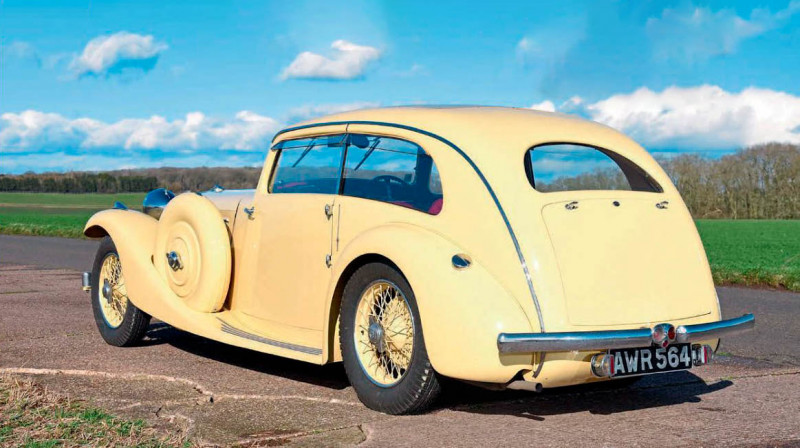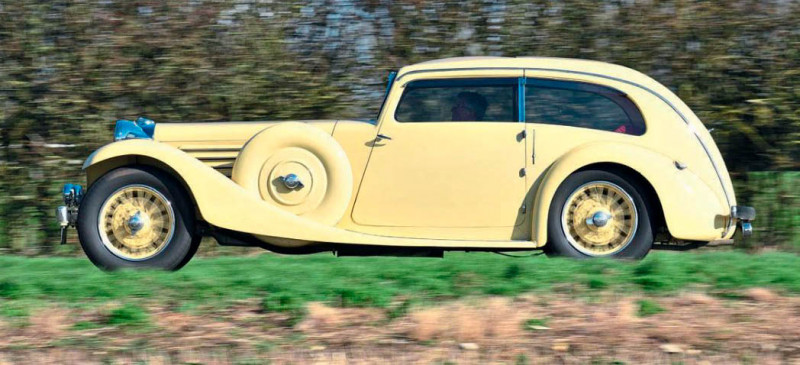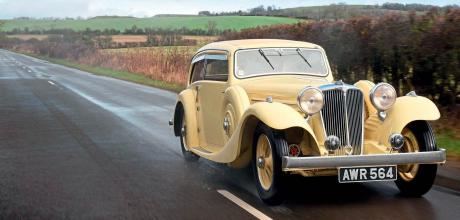1935 SS 1 Airline Saloon
Although it used a chassis and engine sourced from Standard, it can still be argued the S.S.1 was Jaguar’s first car. We explain its history before driving an example of the rare Airline model from 1935. Words Richard Bremner. Photography Paul Walton.
S.S.1 AIRLINE A look at William Lyons’ first masterpiece, the beautiful S.S.1 Airline from 1934
The Thirties – Heir Line
Even though he owned one, this is a car that (Sir) William Lyons apparently disliked. It shared its bones with one of the most beautiful cars Jaguar produced during its early life, when the marque was branded S.S., but the voguish bodywork of this S.S.1 Airline coupe looked heavy and ill proportioned. Customers thought so too. The Airline went on sale in 1934, and was dropped two years later after only 624 had been built. That makes it rare, but it’s far from being the most admired model in the S.S.1 range.

The S.S.1 Airline did look more modern, but it also looked heavy around the rear
During the Twenties, Swallows had evolved fromsidecarmanufacturer to coachbuilder of bodies based on other manufacturers’ cars, and very successfully too. The next step was obvious – for Swallows to make complete cars. That dream took another step forward in the deal Lyons forged with John Black of the Standard Motor Company, and the inspiration of a cartoon. The deal saw component makers Rubery Owen fabricating chassis to Swallows’ design and delivering them to Standard where they would be fitted with the running gear and 2,045cc six-cylinder engine of the Standard Sixteen.

The chassis was of the dropped-frame variety, the back axle’s leaf springs mounted outboard of the frame rather than underneath it. That allowed the chassis, and therefore the car’s body, to sit much closer to the road, allowing Lyons to achieve the more athletic proportions that he sought.
And the cartoon? In an October 1928 issue of The Autocar magazine there appeared a rather fine, caricatured sketch of a generic ‘Sportsman’ coupe. It was drawn by notable artist Gordon Crosby, its subject a low-slung coupe with an absurdly long bonnet. Twomen gaze upon it, one Crosby himself, the otherMontagu Tombs, the author of the accompanying article.
One of them has his hands held wide apart, to emphasise the bonnet’s length. At the time, cars featuring this elegantly racy look were the preserve of Bentley and Bugatti. Absurd it may have looked, but with three theoretical feet shorn from its theoretical length, it would have looked beautiful with its long wheelbase and cab-rear proportions.
Lyons and business partnerWilliam Walmsley thought there would be a market for the same idea at a much lower price. The process of actually developing a new model was very different 100 years ago. Car companies didn’t have design studios, and while the inspiration for the Walmsley and Lyons sidecar business was all about style, neither did Swallows. As the excellent Jaguar Design – A Story of Style by former designer, Nick Hull, reveals, the main sources of automotive illustration were magazines and the photo-engraving studios that produced artwork for car brochures. As it happened, publishers Iliffe Press owned both Coventry-based British Photo-Engraving and The Autocar, and Lyons was close to both, the magazine’s journalists a good source of knowledge and news.
Lyons consulted sales people at dealer Henlys, previous bulk-buyers of his cars, and staff at Iliffe about the direction S.S.’s next models should take. Donald Reesby, the chief artist at British Photo-Engraving, produced an illustration that Lyons liked very much. Its proportions bore a strong resemblance to the 1928 Crosby cartoon, although it’s not known whether that directly influenced Reesby. He would almost certainly have seen Crosby’s sketch, however.
From the Reesby illustration, Lyons and his talented coachbuilder Cyril Holland built the car up around the first fresh-minted S.S. chassis, which arrived from Rubery Owen in the summer of 1931. The aim was to have this car ready for display at the London Olympia Motor Show that autumn. During the build Lyons was struck down with appendicitis, removing him from the process for six weeks. When he got back, he did not see the car he was expecting but a version with a higher roof, ruining its proportions. Walmsley had ordered it to be raised to improve headroom. Lyons was allegedly furious, but it was too late to do anything to a car whose cockpit, “looks like a conning tower,” he reckoned.
The S.S.1 would not be the company’s only new Olympia reveal. A smaller version of the same idea, based on a Standard Little Nine and called S.S.2, also appeared along with the existing Austin Seven, Standard Nine and Wolseley Hornet Swallows to give the company a five-car range. As it had done before, dealer group Henlys ordered 500 S.S.1 units, more than bankrolling the production costs.
Lyons had not finished with the S.S.1, however. During 1932 he and Holland set about redesigning it to achieve the proportions originally intended. The wheelbase was stretched by seven inches, the bonnet raised to create a very shallow, letterbox-like windscreen. The wings and running boards were more flowing, the doors reshaped, the radiator restyled and the headlamps set further apart. The result was at once graceful, elegant, dramatic and finely wrought in the details. It would be the first of many exquisitely realised cars from William Lyons.
It was followed in 1933 by a four-seat S.S.1 open tourer and a year later by an S.S.1 4-Light saloon, with rear side windows rather than the broad, vinyl-covered D-pillars. If anything this was even more stylish than the original coupe, the saloon soon outstripping its sales. S.S. Cars’ success encouraged a particularly active year of product development in 1934, the most significant being the start of work on an allnew S.S. Jaguar saloon. But among the new launches was the S.S.1 Airline, as featured here, which appeared in October.
It was a car inspired by a fad and the efforts of The Autocar’s editor, who was said to have provided a drawing for Lyons. Supposedly streamlined, aerodynamic cars achieved a brief popularity in the Thirties – MG, Hillman, Rover, Singer, Talbot and Triumph all producing models with a continuous, steep-swooping fastback of varying degrees of beauty. There was likely little improvement in the car’s aerodynamics, but the look was usually racily neat, and in a few cases actually beautiful. Most were called Airlines, the (decidedly ugly) Singer an Airstream.
The S.S.1 Airline ought to have been a good idea, a handsome car rendered more rakish with some curvedly refashioned bodywork. Plenty of detail changes also altered this S.S.1’s visual character, but it was the Airline’s silhouette and rear end that changed the most. The roofline began an increasingly steep descent just aft of the rear axle, plunging in an unbroken arc to terminate just below the bumper. The side window treatment changed too. There was now no B-pillar, sealing achieved simply by overlapping the rear side glass and the glazing of the doors, which were rear-hinged.
The front section of the car was altered too. There was no longer room for a spare in the tail, the wheel now mounted just behind the front wing. To even things up, another spare was mounted on the opposite side, the two fitted with body-coloured shrouds. It lent the S.S.1 something of an American look reminiscent of Cords and Duesenbergs, especially with the bonnet louvres cut horizontally rather than vertically.
The S.S.1 Airline did look more modern, but it also looked heavy around the rear and was indeed heavier in reality. Lyons’ customers were fast getting used to S.S. cars that looked handsome from every angle, but the Airline was not one of them, and he was very disappointed with the result. It is, nevertheless, an interesting car today and merely an unhappy variant of a car that was very successful. It is also very much of its time, reflecting the brief fashion for aerolook cars with a touch of the art deco design movement in their details.
The example in the Jaguar Daimler Heritage Trust collection was built in March 1935, six months after the model was announced, for a Captain S Clough who had ordered it from the SS dealer in Harrogate. Its second owner, an LA Kirby, bought it in 1948 and kept it until 1984, when it was bought by a Jaguar museum. A decade later the S.S.1 was acquired at auction by the Jaguar Daimler Heritage Trust. So it’s led a charmed life for several decades. And whatever one’s thoughts about its proportions, this Airline is certainly a compelling sight, what with its cream paintwork, military spotlight-sized headlights and twin wing-mounted spare wheels. The drama of the S.S.1’s long bonnet is somewhat lost to the Airline’s lengthier roof, but it’s still quite an eyeful.
So is the interior, much of which is blood red. The carpets, seats –more sumptuous than you’ll find inmost Thirties machines – are all of this hue, the effect all the more dramatic because the accommodation for those in the rear is shaped like armchairs. And the doors are exquisite y trimmed: the veneer wood capping’s lower edge swoops to a dip above the window winder that’s mirrored by the shape of the carpet at its base.
Between the mis more of that red leather, the centre-piece of which is a pair of embossed storage pouches. Even at this early point in its life, Jaguar was offering extraordinary luxury for the money, the £360 S.S.1 Airline providing the finish of cars costing three times the price. The dashboard is no less impressive, a lustrous slice of wood the setting for the gloss-black ellipse that presents a generous stock of instruments. Among these is an ingenious combined speedometer and tachometer, the engine’s speed in each of the top two gears (there are four in all) illustrated by concentric markings. At a fraction over 3,000rpm in fourth you’ll be advancing at 60mph, then.
Before such heady speeds must come the unfamiliar business of getting in, unless your daily driver happens to be a 21st century Rolls-Royce. Like Goodwood’s luxury cars the Airline’s coach doors have you wondering whether you should reverse yourself into the driving seat. But no need – it’s a wide-opening door and easy to drop onto the red leather, the latch clacking shut behind you. If you’re a little short in the back, as your reporter is, you’ll find yourself sitting a bit low, the S.S.1’s famously long bonnet appearing to rise before you, flanked by the glorious chrome domes of its headlights. The steering wheel is huge, sits quite close to your chest, its spokes sprung.
Effort is needed to shift it at parking speeds, but the need for grunt evaporates on the move. It’s quite accurate, but this is a car that you must steer all the time, its passage frequently directed by the contours of the road below. But you get used to that, if not the ease with which the wheels can be locked on a damp road. The brakes are pretty good – good enough to easily overwhelm the Airline’s slender tyres.
You have to recalibrate of course, driving this car instantly reversing you through 85-odd years of automotive development. The effectiveness of the brakes, and their decent feel underfoot, lull you into thinking that this is a more modern car, however. So does its performance, and the surprising precision of its gearchange. It’s not remotely quick of course, nor even brisk, but the straight-six Standard engine delivers stout and unstressed zest compared to most cars of the day, enabling you to achieve a 50mph cruise with some ease.
Your pace must be substantially pruned before you get to a bend though. Too much, and the rising panic you might feel if running downstairs with an overloaded dinner tray threatens. The physics of friction, velocity and topography are often very present aboard a 1934 car, as are the limitations of tyre designs of the same era. You can sometimes hear your cornering speed crushing rubber, at which point it’s wise to back off.
If all of this makes the S.S.1 feel a bit of a handful, well, it is by 21st century standards or even those of the Eighties. But it’s vastly better than many of its grindingly slow, barely stable contemporaries. It’s a car that you must learn the art of driving, and one that would undoubtedly reward the effort. When you’re in it there’s much to be savoured, from the metal sculpture seen through that shallow screen, to the art deco luxury of the cabin. And from in there, you won’t see the over-heavy slump of the Airline’s rump.
Thanks to: Jaguar Daimler Heritage Trust (www.jaguarheritage.com)
1935 a vert shows three of the S.S.1’s available body styles including the Airline
The S.S.1 Airline did look more modern, but it also looked heavy around the rear



Not heavy Kudos to Richard Bremner for writing such a brilliant piece on the S.S.1 Airline. I’ve often seen that car at Jaguar Heritage’s collection centre in Gaydon so it was great to read more about its history and what it’s like to drive. I will take issue with Richard, though, describing it as “heavy around the rear”. I think – and most will agree – it’s a very handsome car and not at all as Richard described. Thanks again for a great site.